Mostrar el registro sencillo del ítem
Visualización de plasmas convectivos
| dc.creator | Carboni Méndez, Rodrigo | |
| dc.creator | Páez Portuguez, Jorge Eduardo | |
| dc.date.accessioned | 2015-06-19T15:56:06Z | |
| dc.date.available | 2015-06-19T15:56:06Z | |
| dc.date.issued | 2011-02-11 00:00:00 | |
| dc.identifier.citation | http://revistas.ucr.ac.cr/index.php/cienciaytecnologia/article/view/2694 | |
| dc.identifier.uri | https://hdl.handle.net/10669/14592 | |
| dc.description.abstract | We present a study of the evolution of magnetic field in plasmas with different conductivities under the influence of a convective movement independent of time, which allows the description of either a single whirlwind, or even a double one, passing through diverse intermediate configurations. Different numerical methods were utilized in order to study the corresponding equations as, i. e, alternate implicit method, method of Crank-Nicholson, weighted ponderer method, and the convective method as well. This last method is used to solve the induction equation of the vector potential as a functions of the field directly. Also, we analized the stability and consistency of the methods, being the most effective the convective method. The model of a convective cell is described by using current functions. By taking two functions each one of those representing a whirlwind, thy can be modified in such a way, that it may represent either a single or a double whirlwind with just the variation of a parameter. The information gained from the evolution of tha magnetic field under such conditions can be depicted graphically in a sequential manner (film), ths allowing the visualization of the evolutions of the magnetic strengh and the density of energy with time within the convective zone. The amplification of the field strength on the periphery of the cell shows the reconnection and disappearance of the magnetic field lines within the cell, with the corresponding decreasing the field strength thereabout until the evolutions reach a steady state. When the Reynolds number is large, a single whirlwind can reach the steady state in a direct manner, while the double whirlwind began to oscillate for all Reynolds numbers values. | |
| dc.description.abstract | Presentamos en este trabajo la evolución del campo magnético en plasmas de diversas conductividades, sometido a un movimiento convectivo independiente del tiempo, que permite describir desde un torbellino simple hasta uno doble, pasando por las diversas configuraciones intermedias. Se utilizan direfentes métodos numéricos (Smith, 1965) para la resolución de la ecuación correspondiente: diferencias finitas centradas de segundo orden, método implícito de dirección alternante, método implícito de dirección alternante, método implícito de Crank-Nicolson, método del promedio ponderado y método convectivo. Este último se aplica para resolver la ecuación de inducción en función, tanto del potencial vectorial, como en función del campo directamente. Se estudia la estabilidad y consistencia de los métodos, siendo el más efectivo el método convectivo. El modelo de celda convectiva que resolvimos es descrita por medio de funciones corrientes. Tomamos dos funciones que representan torbellinos que pueden modificarse desde unon simple hasta uno doble con la simple variación de un parámetro. La información de la evolución del campo magnético del plasma ganada bajo dichas condiciones, es desplegada en forma gráfica y de manera secuencial, obteniéndose una película que permite visualizar de manera clara, la evolución de la intensidad magnética y la densidad de energía magnética con el tiempor en la zona convectiva . La amplificación del campo en la periferia de la celda permite observar a las líneas de campo reconectarse y desaparecer, disminuyendo la intensidad media del campo hasta que la evolución alcanza un estado estacionario. Para números de Reynolds altos los torbellinos simp,les llegan al estado estacionario de una manera directa, mientras que los torbellinos dobles lo hacen de una manera oscilatoria (para todos, los números de Reynolds). | |
| dc.relation.ispartof | Revista de Ciencia y Tecnología Vol. 20 Núm. 1 y 2 | |
| dc.title | Visualización de plasmas convectivos | |
| dc.type | artículo original | |
| dc.date.updated | 2015-06-19T15:56:06Z | |
| dc.language.rfc3066 | es |


